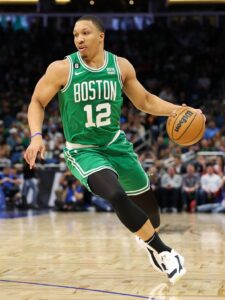Of the eight free players on our list of top 50 free agents who have yet to reach new deals, five are restricted free agents. Those five restricted free agents are also the only ones still available at all (not including those coming off on two-way deals). Those players are as follows:
 P.J. Washington (Hornets)
P.J. Washington (Hornets)- Grant Williams (Celtics)
- Matisse Thybulle (Trail Blazers)
- Ayo Dosunmu (Bulls)
- Paul Reed (Sixers)
While I’m sure these five players would’ve preferred to agree to lucrative new contracts in the opening hours of free agency, it’s not necessarily an ominous sign that they’ve yet to line up new deals four days later. It can sometimes take a little longer for the market for restricted free agents to develop, but it doesn’t mean they won’t get paid.
A year ago, for instance, Deandre Ayton didn’t sign his maximum-salary offer sheet with the Pacers (which was quickly matched by the Suns) until July 14, two weeks after the start of free agency. Collin Sexton, who received a four-year, $71MM in a sign-and-trade deal that sent him to Utah as part of the Donovan Mitchell blockbuster, didn’t resolve his restricted free agency until September.
The same thing happens with a few restricted free agents just about every year. In 2021, RFAs like Josh Hart (three years, $38MM) and Lauri Markkanen (four years, $67MM) took multiple weeks to reach new contract agreements.
In other words, there’s still plenty of time for Washington, Williams, Thybulle, Dosunmu, and Reed to find deals they like.
Washington, Williams, and Thybulle, in particular, seem like good bets to cash in sooner or later. A report over the weekend indicated that Washington was drawing interest from multiple teams besides the Hornets. Williams has reportedly received interest from Charlotte and Dallas, with the Mavericks also said to be keeping an eye on Thybulle.
It would be a surprise if any of them had to settle for a below-market deal. It sounds like teams are still in the process of figuring out if an offer sheet will be an exercise in futility or if there’s a legitimate chance to pry away one of those players from his current club — and if so, what the price point would be.
There hasn’t been as much chatter about Dosunmu or Reed, but there haven’t been any red flags on either front. Their qualifying offers ($5.2MM for Dosunmu; $2.3MM for Reed) remain in place as one-year fallback options.
The Spurs are the one team that still has enough cap room to make a strong play for any of those top RFAs, if they so choose. The Rockets may also be able to offer more than the full mid-level, depending on how all their moves shake out, and teams below the tax apron are free to try to negotiate sign-and-trades.
It has become pretty rare for restricted free agents to change teams via offer sheets, but sign-and-trade deals aren’t uncommon — they get the player to his preferred landing spot while ensuring that his old team picks up an asset or two.
There are still several unrestricted free agents whose landing spots will be worth watching too, including Christian Wood, Kelly Oubre, Hamidou Diallo, Jaylen Nowell, and Dario Saric. But at this point in free agency, it’s the RFA market that looks more intriguing.